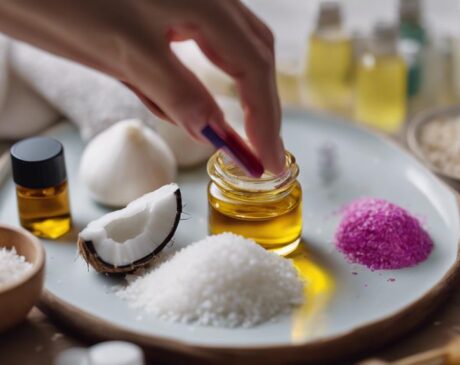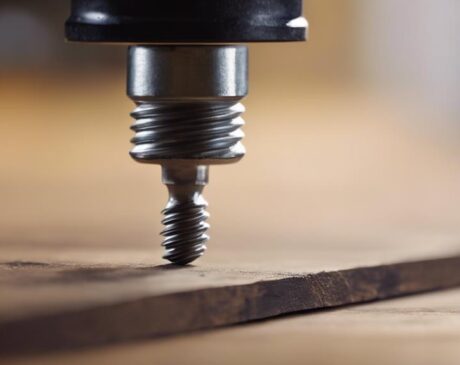What Happens if You Wear Press-On Nails Too Long?
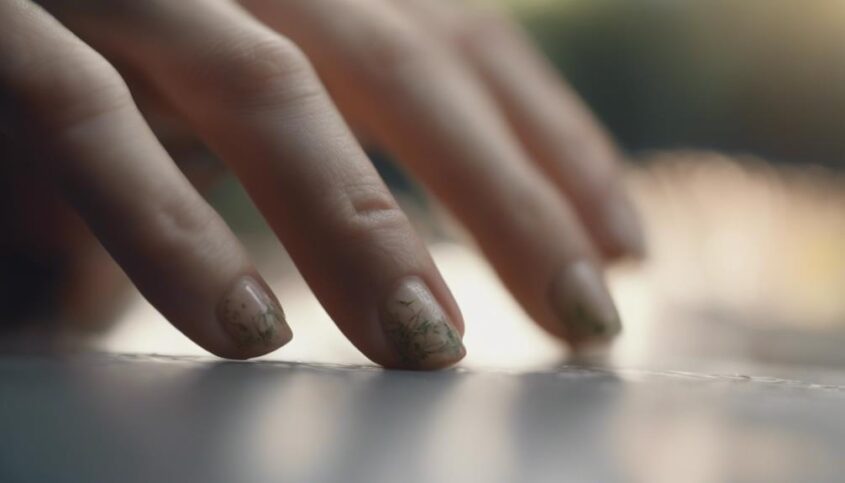
Wearing press-on nails for an extended period may cause nail damage, infections, weakened and brittle nails, discoloration, and potential allergic reactions. It's essential to be mindful of wear duration and practice proper nail care. To prevent issues, allow breaks for nails to recover and stick to safe wear duration guidelines. Implement good nail hygiene to avoid fungal infections, and seek professional help for safe nail removal. Understanding the risks can help maintain healthy nails.
Key Takeaways
- Prolonged wear weakens, thins, and damages natural nails.
- Increased infection risk due to bacterial and fungal growth.
- Adhesives cause nail brittleness and dehydration over time.
- Discoloration and allergic reactions can occur from chemical exposure.
- Difficulty in removal and pain from prolonged pressure and tight-fitting nails.
Nail Damage
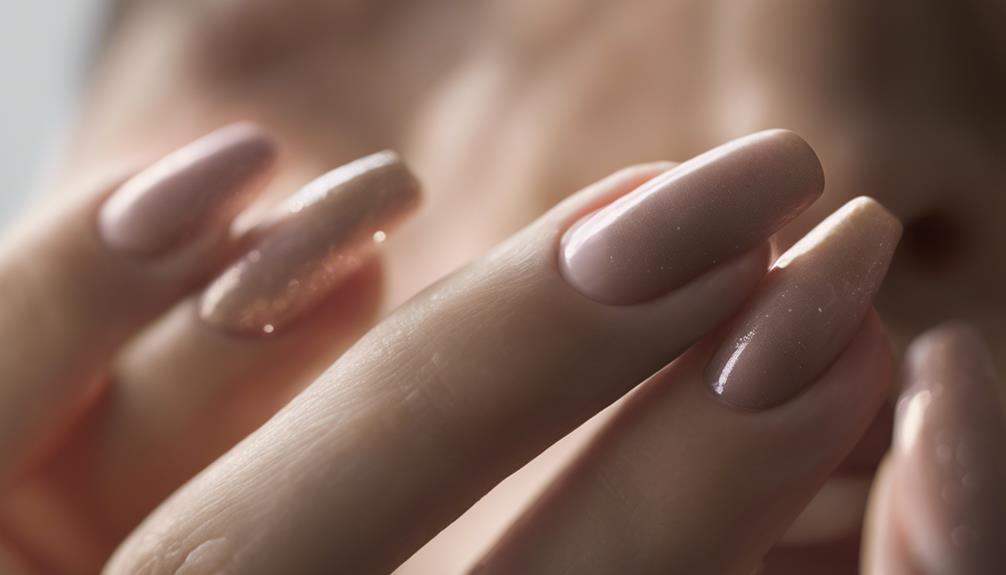
Prolonged wear of press-on nails can lead to significant nail damage, including thinning, weakening, and peeling of the natural nails. While press-on nails offer a convenient and quick way to achieve stylish manicures, it is essential to be aware of the potential consequences of extended use. The adhesive used to attach press-on nails can strip away the natural oils in the nails, causing them to become brittle and prone to breakage. Additionally, the weight of the press-on nails can weaken the nail bed over time, leading to thinning and increased fragility.
To mitigate the risk of nail damage from wearing press-on nails too long, it is advisable to give your nails breaks between applications to allow them to breathe and recover. Regularly moisturizing your nails and cuticles can also help maintain their strength and flexibility. Furthermore, opting for high-quality press-on nails and proper application techniques can minimize the negative effects on your natural nails, ensuring that your manicures remain a fun and safe way to express your style.
Infection Risk
While some may overlook it, wearing press-on nails for an extended period can increase the risk of nail infections. The adhesive used to attach press-on nails creates a seal that can trap moisture and bacteria underneath, leading to potential infections. Here are four key points to consider regarding the infection risk associated with prolonged use of press-on nails:
- Bacterial Growth: The warm and moist environment under press-on nails can promote the growth of harmful bacteria, increasing the likelihood of infections.
- Fungal Infections: Fungi thrive in dark and humid conditions, making the space between the natural nail and the press-on nail a perfect breeding ground for fungal infections.
- Skin Irritation: Prolonged wear of press-on nails can cause skin irritation around the nail bed, making it more susceptible to infections.
- Impaired Nail Health: Continuous use of press-on nails can weaken the natural nails, making them more prone to damage and infections in the long run.
Considering these factors, it is essential to pay attention to proper nail care and hygiene to minimize the risk of infections associated with wearing press-on nails for an extended period.
Weakness and Brittle Nails
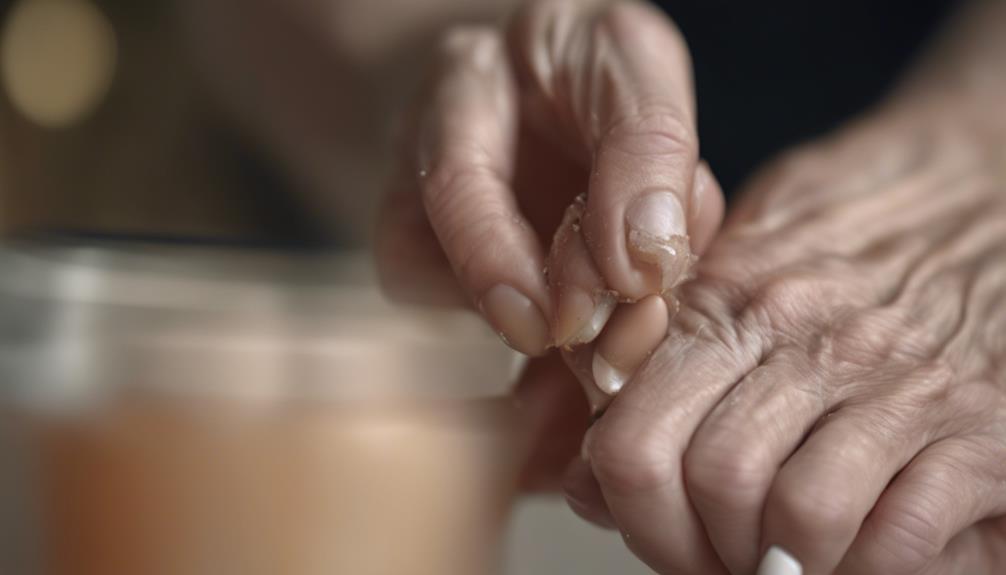
Long-term use of press-on nails can lead to weakness and brittleness in natural nails. This weakening can occur due to the prolonged exposure to adhesives and lack of moisture reaching the nail bed. Consequently, individuals may experience nail damage and potential health concerns as a result.
Nail Damage
Excessive wear of press-on nails can lead to weakened and brittle nails, diminishing the overall health and strength of the natural nails. This weakening effect can be attributed to various factors, including:
- Reduced Oxygen Flow: Prolonged use of press-on nails can limit the amount of oxygen reaching the natural nail bed, leading to decreased nail health.
- Chemical Exposure: The adhesives and substances used in press-on nails may contain harsh chemicals that weaken the natural nails over time.
- Moisture Loss: Press-on nails can trap moisture against the natural nail, causing dehydration and making them prone to brittleness.
- Structural Damage: Continuous use of press-on nails can alter the structure of the natural nails, making them more susceptible to breakage and damage.
Health Concerns
Prolonged use of press-on nails can result in weakened and brittle natural nails, posing health concerns related to nail strength and integrity. The adhesives used to attach press-on nails can dehydrate the nail bed, making the natural nails dry and prone to breakage. Continuous use of press-on nails without allowing the natural nails to breathe and recover can lead to a decrease in nail flexibility and overall health. To mitigate this issue, it is advisable to give the nails regular breaks from press-on nails, moisturize the natural nails, and use strengthening treatments. Prioritizing nail health over extended wear of press-on nails can help prevent weakness and brittleness, promoting stronger and healthier nails in the long run.
Nail Discoloration
Nail discoloration is a common consequence observed in individuals who wear press-on nails for extended periods. This discoloration can manifest in various ways, such as changes in nail color, spots, or stripes. Here are four key reasons behind nail discoloration when wearing press-on nails for too long:
- Chemical Reactions: Prolonged use of press-on nails can lead to chemical reactions between the nail adhesive and the nail bed, resulting in discoloration.
- Lack of Oxygen: Press-on nails can restrict airflow to the natural nail, causing oxygen deprivation and subsequent nail discoloration.
- Moisture Trapping: Moisture can get trapped between the press-on nail and the natural nail, creating a breeding ground for bacteria or fungi that can cause discoloration.
- UV Exposure: Excessive exposure to UV light, whether from sunlight or UV lamps during nail application, can lead to nail discoloration over time.
Allergic Reactions
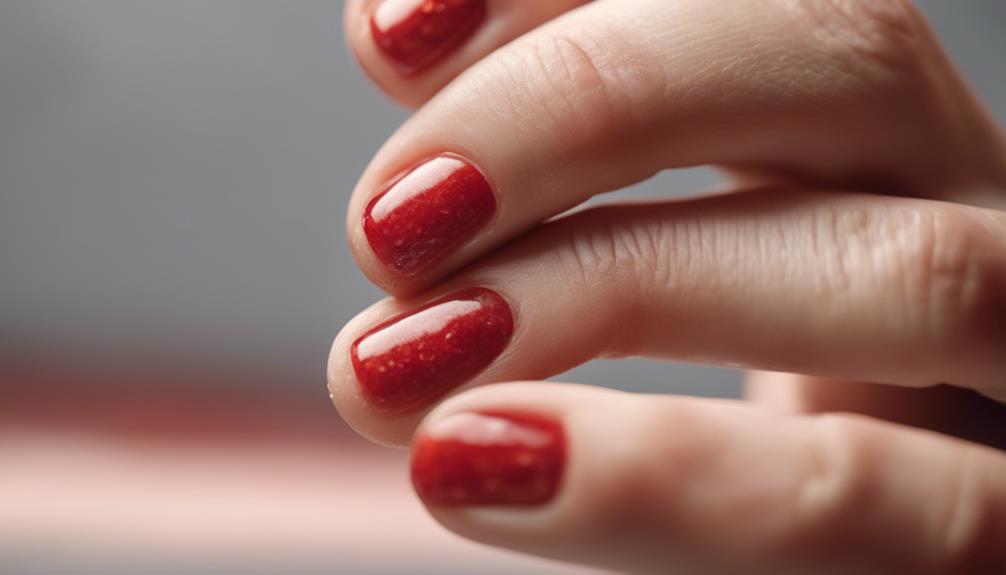
Allergic reactions to press-on nails can manifest as skin irritation risks and various allergy symptoms. Recognizing the signs of an allergic reaction, such as redness, itching, or swelling, is crucial to taking prompt action. To prevent adverse reactions, consider patch testing new nail products and opting for hypoallergenic options.
Skin Irritation Risks
Wearing press-on nails for extended periods may lead to adverse skin reactions, such as irritation and sensitivity, that are commonly associated with certain chemicals present in the adhesives used. These reactions can vary from mild redness to more severe allergic responses. To help you better understand the skin irritation risks associated with prolonged use of press-on nails, consider the following points:
- Chemical Sensitivities: Individuals may develop sensitivities to specific chemicals in the nail adhesives.
- Skin Redness: Prolonged wear of press-on nails can cause redness and inflammation around the nail bed.
- Itching and Discomfort: Some individuals may experience itching and discomfort due to skin irritation.
- Potential Allergic Reactions: In severe cases, prolonged use of press-on nails can trigger allergic reactions, requiring medical attention.
Allergy Symptoms to Watch
Individuals who have been using press-on nails for an extended period should pay close attention to any symptoms that may indicate an allergic reaction. Allergic reactions to the adhesives or materials in press-on nails can manifest in various ways. Watch out for symptoms such as redness, itching, swelling, or a rash around the nail area. Some people may also experience blistering, peeling skin, or a burning sensation. In severe cases, allergic reactions can lead to difficulty breathing or a tightening sensation in the chest. If you notice any of these symptoms, it is essential to remove the press-on nails immediately and seek medical advice. Ignoring allergic reactions can worsen the condition and lead to further complications.
Tips for Prevention
To prevent adverse reactions associated with prolonged use of press-on nails, it is crucial to implement proactive measures that minimize the risk of developing allergies to the nail adhesives and materials. Here are four innovative tips for preventing allergic reactions:
- Patch Testing: Before applying press-on nails, conduct a patch test on a small area of skin to check for any allergic reactions.
- Use Hypoallergenic Products: Opt for hypoallergenic nail adhesives and materials to reduce the likelihood of triggering an allergic response.
- Limit Wear Time: Avoid wearing press-on nails for extended periods to lower the risk of developing sensitivities to the components.
- Proper Removal: Follow proper removal techniques to prevent damaging the natural nails and causing irritation that could lead to allergies.
Nail Fungus
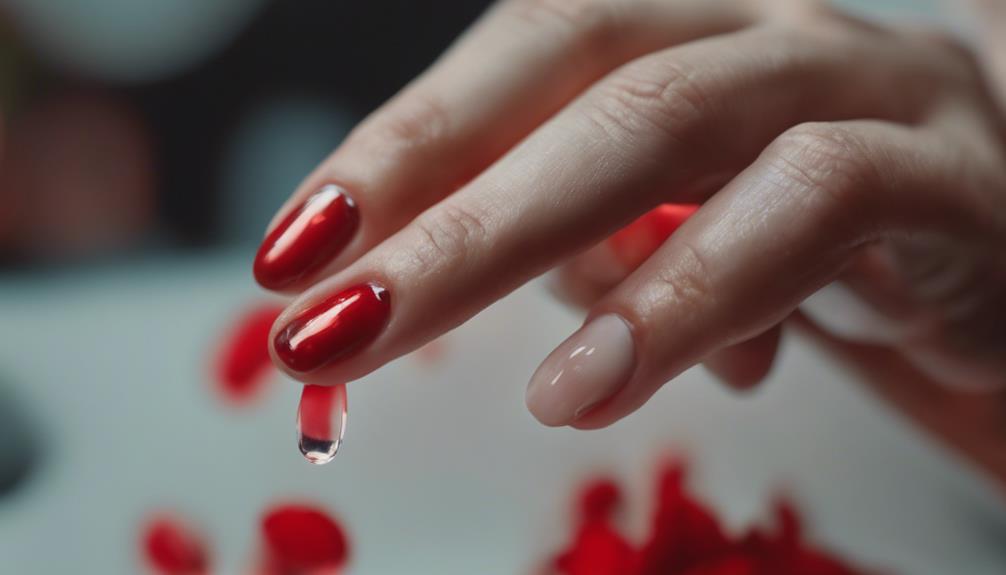
Nail fungus, a common infection that affects the nails, can result from prolonged wear of press-on nails. The warm and moist environment created between the artificial nail and the natural nail provides an ideal breeding ground for fungi to thrive. Fungi are microscopic organisms that can cause the nails to become discolored, thickened, and brittle. In severe cases, nail fungus can lead to pain and permanent damage to the nail bed.
To prevent nail fungus from developing, it is essential to practice good nail hygiene. This includes keeping the nails clean and dry, avoiding sharing nail tools, and giving the nails a break from press-on nails to allow them to breathe. Additionally, using antifungal treatments as a preventive measure can help protect the nails from infection.
Innovations in nail care, such as antifungal nail polishes and treatments, offer effective solutions for combating nail fungus. These products contain ingredients that target fungi while promoting overall nail health. By staying informed about nail care innovations and practicing good hygiene, individuals can minimize the risk of developing nail fungus from wearing press-on nails.
Pain and Discomfort
Prolonged wear of press-on nails can lead to discomfort and pain due to the pressure exerted on the nail bed and surrounding skin. This discomfort can range from mild irritation to more severe pain, depending on various factors such as the length of time the press-on nails have been worn and the tightness of the fit. Here are four key points to consider regarding pain and discomfort associated with extended use of press-on nails:
- Nail Bed Damage: Continuous pressure on the nail bed can cause damage, leading to soreness and tenderness.
- Skin Irritation: The adhesive used to attach press-on nails can irritate the skin around the nail, causing redness and discomfort.
- Nerve Sensitivity: Prolonged pressure on the nails can increase sensitivity in the nerves, resulting in pain even after the nails are removed.
- Restricted Blood Flow: Tight-fitting press-on nails can restrict blood flow to the nail bed, causing discomfort and potentially leading to more serious issues if left unaddressed.
Difficulty Removing Nails
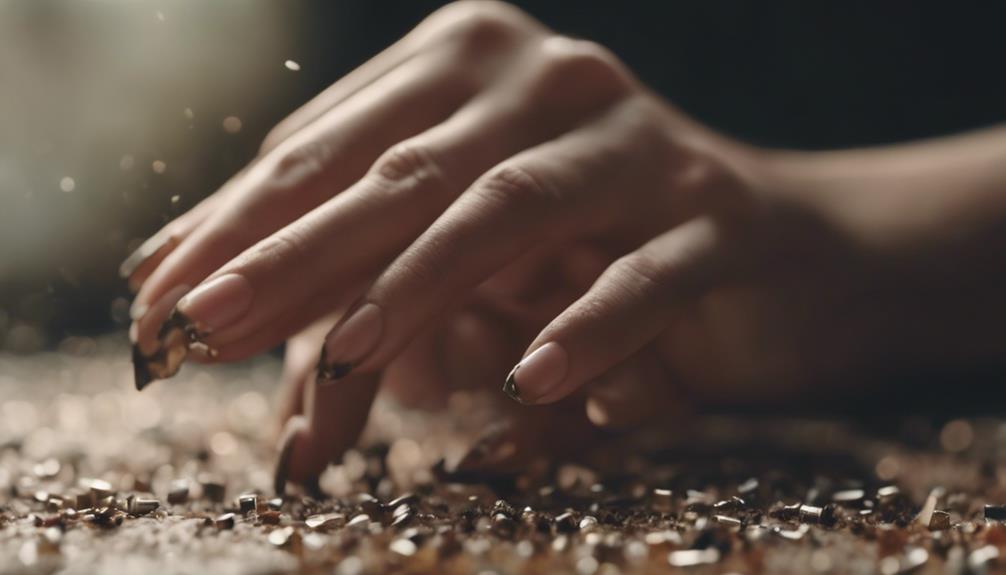
Struggles may arise when attempting to detach press-on nails that have been worn for an extended period. The longer the press-on nails remain in place, the stronger the adhesive bond becomes, making removal more challenging. This can lead to frustration and potential damage to the natural nails if not approached carefully.
Innovations in the beauty industry have introduced various techniques to overcome this issue. One method involves soaking the nails in warm, soapy water to help loosen the adhesive before gently peeling off the press-ons. Alternatively, using acetone or nail polish remover can effectively dissolve the glue, easing the removal process.
However, caution must be exercised to prevent excessive scraping or forceful removal, as this can weaken the natural nails and cause discomfort. Seeking professional assistance from a nail technician is advisable if experiencing significant difficulties in removing press-on nails safely.
Frequently Asked Questions
Can Press-On Nails Cause Long-Term Damage to the Natural Nails Underneath?
Long-term wear of press-on nails can lead to potential damage to the natural nails underneath. Continuous use may cause weakness, thinning, and brittleness, affecting the overall health of the nails. Proper care and maintenance are essential to minimize these risks.
How Likely Is It to Develop an Infection From Wearing Press-On Nails for an Extended Period of Time?
Extended wear of press-on nails increases the risk of infection due to trapped moisture and bacteria. Neglecting proper nail care and maintenance can lead to fungal or bacterial growth. It is crucial to prioritize hygiene and nail health.
Will Wearing Press-On Nails for Too Long Result in Weaker and More Brittle Natural Nails?
Prolonged wear of press-on nails could potentially lead to weakened and more brittle natural nails. Excessive use may hinder the breathability of the nail bed, impacting overall nail health. Regular maintenance and breaks are advisable.
Can Press-On Nails Cause Permanent Discoloration or Damage to the Natural Nails?
Press-on nails, when worn for extended periods, can potentially lead to permanent discoloration or damage to natural nails. This may be due to lack of ventilation and moisture accumulation. Regular breaks and proper nail care are recommended.
Are Allergic Reactions Common When Wearing Press-On Nails for an Extended Period of Time?
Allergic reactions while wearing press-on nails for extended periods are uncommon but possible. It's crucial to monitor for any signs of irritation or sensitivity. Seeking professional advice and using high-quality products can help minimize the risk of adverse reactions.

